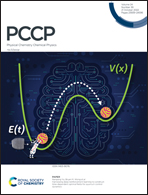Effects of hydrogen bonds on the single-chain mechanics of chitin†
Abstract
Water is essential in the evolution of life and plays an important role in the structure and function of the basic substances of life, such as protein and DNA. However, the specific details of the role of water with respect to chitin, the most abundant biomacromolecule on Earth after cellulose, remain unclear. In this study, atomic force microscopy (AFM)-based single-molecule force spectroscopy (SMFS) was used to explore the effects of hydrogen bonds (H-bonds) on the single-molecule mechanics of chitin. Comparative experiments showed that a single chitin chain exhibited the same single-chain natural elasticity as cellulose in nonane, indicating that a single chitin chain can form strong intrachain H-bonds in nonane. Moreover, the single-chain elasticity of chitin obtained in dimethyl sulfoxide (DMSO) was consistent with that of cellulose, and both superposed well with the theoretical model (QM-FJC) to show the single-chain elasticity of the chitin/cellulose backbone, indicating that DMSO can eliminate almost all the intrachain H-bonds of single chitin chains. However, when water was introduced as the surrounding environment, the intrachain H-bonds of chitin were found to be weaker than those of cellulose, which is supported by the AFM mapping results. Single-molecule studies reveal that water is a unique solvent for chitin, and the nanomechanics and hydrophobicity of chitin can be influenced by an external solvent (water in this work) through regulation of the intrachain H-bonds. The present study casts new insight into the role of H-bonds and water in the structures and functions of polysaccharides.



 Please wait while we load your content...
Please wait while we load your content...